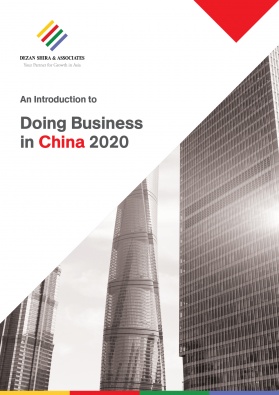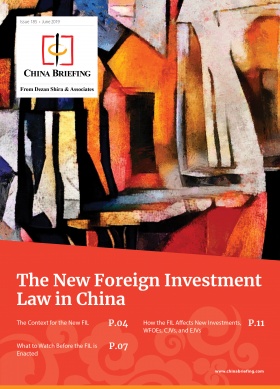China’s 2019 Trademark Law Amendment: What’s New
- The latest amendment to China’s Trademark Law took effective November 1, 2019, and the regulatory guidelines to implement the law came into effect December 1, 2019.
- The 2019 Trademark Law is expected to strengthen the country’s trademark protections, aggressively targeting bad faith trademark applications and increasing the punitive consequences for trademark infringement.
China’s latest Trademark Law Amendment was passed by the Standing Committee of the thirteenth National People’s Congress on April 23, 2019 and the revised articles (Articles 4, 19, 33, 44, 63, and 68) became effective on November 1, 2019.
The latest amendment addresses two longstanding concerns of the business community in the country – tackling bad faith trademark applications and intensifying the punishment for trademark infringement.
To facilitate the implementation of the new amendment to the trademark law, on October 11, 2019, China’s State Administration of Market Regulation (SAMR) rolled out Certain Provisions for Regulating Applications for Trademark Registration (“Provisions”), which came into force beginning December 1, 2019.
How to read the changes in the 2019 amendment
Prohibiting bad faith trademark filings (Articles 4, 33, 44)
The most notable improvement to the Trademark Law is a new provision added to Article 4, which allows the China Trademark Office (CTO) to reject malicious trademark applications at the application or initial examination stage. To reinforce this, the law has made changes to Articles 33 and 44, which allow malicious trademark registrations to be opposed or invalidated as well.
Article 4 – rejection of bad faith filings at the initial examination stage
The new provision added to Article 4 says: “malicious trademark registration without an intention to use should be rejected.” That means the law empowers the CTO to deny bad faith trademark filings at the application or initial examination stage and will enable the outright eviction of trademark squatters and hoarders from all commercial channels.
Article 33 – objection of bad faith applications during the announcement period
After the initial review by the CTO, there will be a three-month announcement period. During this period, the brand owner or any other interested party can lodge an objection with the CTO if they believe there is a bad faith application. If verified, the CTO has the right to reject the bad faith application.
Article 44 – cancellation of bad faith registrations through invalidation proceedings
If a violation of Article 4 was found, the CTO can invalidate the registration of a maliciously registered trademark. Any other organization or individual can also request the National Intellectual Property Administration (CNIPA), to declare the said trademark invalid.
Increased legal compensation for trademark agencies
Article 19 – compliance by trademark agency
Based on the changes made to Article 4, the new law also put the onus on third-party trademark agencies to act responsibly. The article stipulates that a trademark agency cannot accept the commitment if it is aware the trademark to be registered by a client is in bad faith.
Article 68 – punishment for trademark agency found to be in violation of Article 4
If the trademark agency violates Article 4, it may face administrative penalties. If no rectification was made within the prescribed time limit, the trademark agency may face a fine ranging from RMB 10,000 to 100,000 (US$1,422 to 14,220). Individuals directly in charge or directly responsible may be given a warning and a fine ranging from RMB 5,000 to 50,000 (US$711 to 7,110). If the case constitutes a crime, criminal responsibility will be investigated by law.
Intensified punishment for trademark infringement
The new amendment has increased the extent of punitive damages in cases of “malicious and serious” trademark infringement.
The maximum amount of damages that can be demanded is increased to one to five times the relevant base amount (that is, the actual damage); previously it was one to three times the relevant base amount.
Where it is impossible to calculate the base amount, the maximum amount of statutory damages is increased from RMB 3 million to RMB 5 million (approx. US$427,200 to US$712,000).
Further, except in “special circumstances”, at the request of the trademark holder, goods bearing counterfeit trademarks and the tools and materials used for manufacturing such goods can be destroyed without compensation upon judgment by the courts.
Commodities bearing the counterfeit trademarks will be banned from entering commercial channels even after the said trademarks have been removed.
Expert opinion on the new changes in China’s trademark regime
Fanny Zhang, Business Advisory Services Manager at Dezan Shira and Associates’ Beijing office, says: “due to the first-to-file system in China, Chinese trademark hoarders were able to leverage a legal void to file a pile of trademarks for registration – in order to sell or obtain illegitimate benefits from them rather than to use them.
“This is primarily why China has stepped up its crackdown on trademark squatters by revising the law and setting up IP courts. Further, previous laws and regulations lacked clear and operative provisions on combating malicious trademark applications at early stages and failed to curtail trademark hoarding.”
In this context, “the Trademark Law needed to be further amended to provide a solid legal basis for the eradication of malicious trademark applications – from the beginning.”
In practice, the CNIPA and the People’s Courts of China have been citing the original Article 4 of the Trademark Law to reject trademark applications. In 2018, the CTO denied around 100,000 abnormal trademark applications at the application and objection stages. Now, “with the new amendment, the current practices have become codified and have more solid legal ground,” Fanny added.
There is no doubt that these amendments are welcome and are good for building a fair market, although there are still questions about the definition of “bad faith trademark application without an intention to use” in Article 4 and the future implementation of the new amendment.
Nevertheless, as mentioned earlier, the market regulator SAMR has directed the CTO through the Provisions issued in December to examine key factors during the application stage, which will enable them to spot bad faith registrations. SAMR also put out measures to regulate these behaviors.
Factors to be examined by the CTO include:
- The number, the categories designated for use, and the trading status of trademarks applied by the applicant or any natural person, legal person, or other organization associated with the applicant;
- The applicant’s industry and business status;
- Whether the applicant was found engaging in acts of malicious trademark registration or trademark infringement by an effective administrative decision or ruling, written order, or judicial judgment;
- Whether the trademark applied is identical or similar to someone else’s trademark with a certain popularity;
- Whether the trademark applied is identical or similar to the name of a well-known person, the name or short name of an enterprise, or other commercial marks; and
- Other factors that the CTO believes need to be considered.
However, more clarification and updated regulations are still needed. For example, an inevitable question that arises is – will the new amendment law encourage trademark pirates to actually use the trademarks and somehow provide the evidence to legitimate their registration or will the law bring trouble for businesses that want to register trademarks in good faith?
Legal experts still await more updated regulations and a list of typical cases of malicious trademark applications handled in recent years, which the CNIPA has promised to release soon.
Foreign brand owners are advised to stay abreast of the latest developments and take advantage of the new amendment in opposition and invalidation proceedings if applicable. It is also advised to seek local expertise for help when the case becomes complicated.
About Us
China Briefing is written and produced by Dezan Shira & Associates. The practice assists foreign investors into China and has done since 1992 through offices in Beijing, Tianjin, Dalian, Qingdao, Shanghai, Hangzhou, Ningbo, Suzhou, Guangzhou, Dongguan, Zhongshan, Shenzhen, and Hong Kong. Please contact the firm for assistance in China at china@dezshira.com.
We also maintain offices assisting foreign investors in Vietnam, Indonesia, Singapore, The Philippines, Malaysia, and Thailand in addition to our practices in India and Russia and our trade research facilities along the Belt & Road Initiative.
- Previous Article Consolidated Audits for Holding Companies in Hong Kong: 3 Commonly Asked Questions
- Next Article Coronavirus: Impact on China and ASEAN, Businesses Need to Implement Remote Administration









